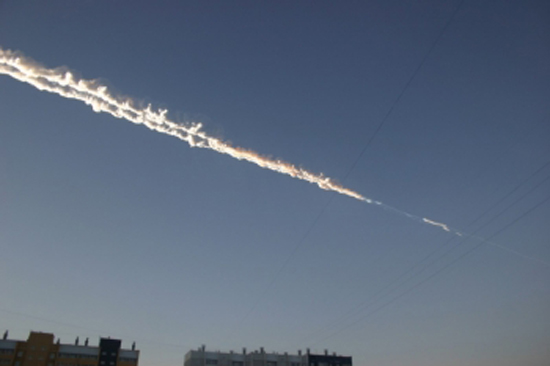Russian Meteor Explosion Not Caused by Asteroid Flyby, NASA Scientist Says

Update: For complete coverage of the Russian meteor explosion, including videos, photos and analysis, read: Meteor Blast Over Russia Feb. 15: Complete Coverage
The meteor explosion over Russia that injured more than 500 people and damaged hundreds of buildings was not caused by an asteroid zooming close by the Earth today (Feb.15), a NASA scientist says.
NASA asteroid expert Don Yeomans, head of the agency's Near-Earth Object Program Office, told SPACE.com that the object which exploded over a thinly inhabited stretch of eastern Europe today was most likely an exploding fireball known as a bolide.
More than 500 people were injured, mostly by glass cuts when windows shattered during the blast, according to the Russian Emergency Ministry.
"If the reports of ground damage can be verified, it might suggest an object whose original size was several meters in extent before entering the atmosphere, fragmenting and exploding due to the unequal pressure on the leading side vs the trailing side (it pancaked and exploded)," Yeomans told SPACE.com in an email. "It is far too early to provide estimates of the energy released or provide a reliable estimate of the original size." [Photos of Russia's Meteor Fireball Blast]
Yeoman stressed that the bolide event was likely not associated at all with the incoming asteroid 2012 DA14, which will fly within 17,200 miles (27,000 kilometers) of Earth when it passes safely by our planet today.
"The asteroid will travel south to north," Yeomans said. "The bolide trail was not south to north and the separation in time between the fireball and 2012 DA14 close approach is significant."
Get the Space.com Newsletter
Breaking space news, the latest updates on rocket launches, skywatching events and more!
Asteroid 2012 DA14 is 150 feet (45 meters) wide — about half the size of a football field — and will make its closest approach to Earth at 2:24 p.m. EST (1924 GMT) when it passes over Indonesia. It will be about 5,000 miles (8,046 kilometers) closer to Earth than the communications satellites circling the planet in geosynchronous orbits.
NASA scientists and professional and amateur astronomers around the world have been tracking asteroid 2012 DA14 since it was first discovered by a team of amateurs in February 2012. Not only does the asteroid pose no threat to Earth during today's flyby, but it will not hit Earth for the foreseeable future, NASA scientists have said.
Visit SPACE.com today for complete coverage of asteroid 2012 DA14's flyby.
Editor's note: If you snapped a photo of the meteor explosion over Russia that you'd like to share for a possible story or image gallery, send photos, comments and your name and location to managing editor Tariq Malik at spacephotos@space.com.
You can follow SPACE.com Managing Editor Tariq Malik on Twitter @tariqjmalik. Follow SPACE.com on Twitter @Spacedotcom. We're also on Facebook & Google+.
Join our Space Forums to keep talking space on the latest missions, night sky and more! And if you have a news tip, correction or comment, let us know at: community@space.com.

Tariq is the Editor-in-Chief of Space.com and joined the team in 2001, first as an intern and staff writer, and later as an editor. He covers human spaceflight, exploration and space science, as well as skywatching and entertainment. He became Space.com's Managing Editor in 2009 and Editor-in-Chief in 2019. Before joining Space.com, Tariq was a staff reporter for The Los Angeles Times covering education and city beats in La Habra, Fullerton and Huntington Beach. In October 2022, Tariq received the Harry Kolcum Award for excellence in space reporting from the National Space Club Florida Committee. He is also an Eagle Scout (yes, he has the Space Exploration merit badge) and went to Space Camp four times as a kid and a fifth time as an adult. He has journalism degrees from the University of Southern California and New York University. You can find Tariq at Space.com and as the co-host to the This Week In Space podcast with space historian Rod Pyle on the TWiT network. To see his latest project, you can follow Tariq on Twitter @tariqjmalik.









